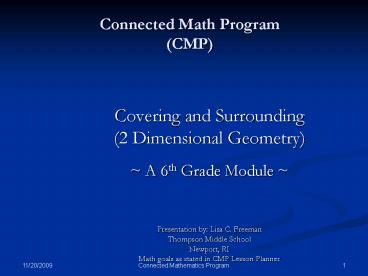Connected Math Program CMP - PowerPoint PPT Presentation
1 / 12
Title:
Connected Math Program CMP
Description:
Develop strategies for finding areas and perimeters of various geometric shapes ... Investigation 2 Measuring Odd Shapes. Students develop techniques for ... – PowerPoint PPT presentation
Number of Views:86
Avg rating:3.0/5.0
Title: Connected Math Program CMP
1
Connected Math Program(CMP)
- Covering and Surrounding
- (2 Dimensional Geometry)
- A 6th Grade Module
- Presentation by Lisa C. Freeman
- Thompson Middle School
- Newport, RI
- Math goals as stated in CMP Lesson Planner
2
Connected Math
- CMP emphasizing hands-on learning, concept
building, and real-world connections - Each Module (unit of study) involves four or more
Investigations (chapters) - Each Investigation contains
- Math Problems (hands-on explorations and
activities) - Homework (ACE Applications, Connections, and
Extensions) - Math Reflection (writing about what was learned)
- Connected Math (CMP) a research-based
middle school math program developed at Michigan
State University and supported by the National
Science Foundation (NSF) under Grant No.
MDR9150217
3
Topics of DiscussionIndex
- Covering Surrounding the Big Ideas (Math
Goals) - Structure of the lessons Launch, Explore,
Summarize - Student Responsibility
- Family Involvement
- Summary
- Websites
4
Covering Surrounding The Big Ideas
- The study of Area and Perimeter
- Develop strategies for finding areas and
perimeters of various geometric shapes - Discover the relationship between area and
perimeter - Discover how the area of a rectangle is related
to the area of a triangle and a parallelogram - Develop formulas, using words and symbols, for
finding area and perimeter of rectangles,
parallelograms, triangles, and circles - Observe and reason from patterns in data by
organizing tables to represent the data - Use multiple representations to describe data
(pictoral, tabular, and symbolic models)
NEXT
5
Covering Surrounding The Investigations
- Investigation 1 Measuring Perimeter and Area
- Students learn that area is represented by the
number of unit squares needed to cover it and
that perimeter is the number of units of length
needed to surround it - Investigation 2 Measuring Odd Shapes
- Students develop techniques for estimating areas
and perimeters of non-geometric figures - Investigation 3 Constant Area, Changing
Perimeter - Students learn that perimeters of rectangles can
vary even when the area is held constant and
connect this idea to the area model for
multiplication - Investigation 4 Constant Perimeter, Changing
Area - Students learn that the areas of rectangles with
a fixed perimeter can vary considerably - Investigation 5 Measuring Parallelograms
- Students discover relationships between
parallelograms and rectangles and develop
techniques or formulas for finding areas and
perimeters of parallelograms - Investigation 6 Measuring Triangles
- Students find and use the relationship between
rectangles and parallelograms, and parallelograms
and triangles to develop techniques for finding
area and perimeter of triangles - Investigation 7 Going Around in Circles
INDEX
6
Structure of the Lesson Launch, Explore,
Summarize
- Launch a time for the teacher to introduce the
problem - Read Aloud
- Understand the question
- Think about possible strategies of approach
- Teach a mini-lesson, if needed to begin the work
INDEX
7
Structure of the Lesson Launch, Explore,
Summarize
- Explore a time for the students to investigate
the math concept - Work independently or in pairs or groups
- Use manipulatives or other resources as needed
- Construct meaning
- Explore, discuss, prove, justify
- Make conclusions
- Complete the recording sheet for the binder
INDEX
8
Structure of the Lesson Launch, Explore,
Summarize
- Summarize a time for the whole class to come
together and share strategies, ideas, and answers - Individuals or groups discuss answers and
strategies - Explain, discuss, prove, justify
- Make conclusions
- Make connections to previous problems or
real-world situations
INDEX
9
Student Responsibility
- Come ready to learn
- Good attitude
- Pencil, binder, book, completed homework
- Actively participate
- Share or Question ideas
- Ask for justification
- Explain thinking
- Share strategies
- Stay focused on math conversations
INDEX
10
Family Involvement
- Ask, What was the math problem about today?
- Ask, What was the big idea of the lesson?
- Ask, How did you explore the concepts?
- To help with homework
- Ask to see the binder page that was worked on in
class - Try to connect the ideas of the days lesson to
the ideas of the homework.
INDEX
11
In Summary
INDEX
- Connected Math allows for hands-on learning,
concept building, and real-world connections - Each Module involves four or more Investigations
(chapters) - Each Investigation is made up of problems (or
activities), homework (ACE Applications,
Connections, and Extensions), and a Math
Reflection - Each student is responsible for keeping up with
class assignments, homework, math reflections,
quizzes and check-ups, a unit test, a performance
task, and a final Math Reflection
12
Websites
- http//www.phschool.com/math/cmp - general
information about CMP from the publisher
(Prentice Hall) - http//www.phschool.com/math/cmp/spanish_glossarie
s.html - Spanish math glossary - http//www.math.msu.edu/cmp - Developer of CMP
- www.schoolnotes.com Use Newport Zip Code 02840
for homework assignments
INDEX































